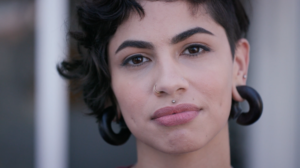Gender is confusing.
There. I said it.
There’s this narrative around gender questioning that tells us that, once we’ve figured ourselves out, we’ll feel a waterfall of relief and clarity and happiness.
Further, this realization should apparently be easy, since we were supposedly “born this way” and, heck, who doesn’t know their own gender?
Well, I’m still waiting for my fucking waterfall of magical clarity over here.
The truth is, questioning our assigned gender can be really hard.
In part because binary gender is everywhere – you’re either a woman or a man. It’s assigned to us from day one, imposed on us our entire lives, and it’s a huge part of our culture in the Western world.
Non-binary gender, however, is less visible in our culture, making it difficult to have any kind of script or model to compare ourselves to. Being non-binary can mean identifying with being both a man and a woman, or only one of those, or neither of them.
How can we figure out what or who we are if we have no examples to follow?
And because gender is this sense of self, and not something we can outwardly perceive – it’s not like a big neon sign will appear over your head or you’ll receive a letter in the mail inviting you to Non-Binary Hogwarts – it can take a long time before we find where we fit.
And if you’re feeling overwhelmed, upset, or even angry, I completely get it.
When I realized I might be non-binary, I felt totally lost. There weren’t many resources for me to turn to at the time, so I drove myself bonkers trying to understand.
Whatever you’re feeling, it’s okay. It’s a part of the process – a process that can be both exciting and terrifying, sometimes at the same time.
To make it a little easier, I’ve put together a beginner’s guide for folks who may be non-binary but aren’t quite sure yet. I have no way of guaranteeing success (and no, there will be no refunds), but I hope that it can be helpful in clearing up some of the confusion and noise.
1. REFRAME: Approach Your Journey with a New Frame of Mind
I remember thinking that discovering my gender identity would help clarify exactly who I was in the scheme of the universe. That once I figured out my gender, everything would be clear to me, and I would no longer experience anxiety or uncertainty around my gender.
That’s a lot of pressure to put on someone.
So before you dive in any further, let me tell you this:
It isn’t about what or who you “really are” – because that’s a question that you’ll likely deal with for your whole life. Instead, think of gender exploration as a way of finding a kind of expression and identity that makes you feel more comfortable.
Gender can be playful, interesting, and even fun. It’s fluid, and sometimes it changes, and there’s no right or wrong way to do it.
Take it slow, and remember that you’re not looking for an ultimate answer, but instead, undertaking a journey – one that, for many trans and non-binary people, is ongoing throughout their lives.
It’s a process – and you should take it at your own pace, on your own terms.
There’s no pressure to arrive at any particular answer. Instead, simply be open to all the possibilities.
2. LEARN: Educate Yourself About What Non-Binary (And Other Gender Terminology) Means
If you haven’t already, a great way to explore gender is to “grocery shop.”
No, I don’t mean it literally!
Check out this list of gender terminology, and keep an ongoing list of any words that you feel connected to.
Next to each of the terms, if you’re able to, write down why you chose that particular phrase or what about it resonated with you. Maybe it’s a memory from a few years back, or just a euphoric feeling you had when you read about it.
For example, when I first saw the word “non-binary,” it really struck me because instead of trying to pinpoint what I was, it captured the one thing I knew at that time – what I wasn’t.
I felt comforted that, while I wasn’t sure how to define my gender just then, I was pretty sure that it didn’t lie within the parameters of “man” and “woman.”
“Non-binary” never tried to define me too specifically, but instead, simply affirmed what I wasn’t. It left room for me to, from there, explore exactly what my gender really was.
Are there words that you’ve seen that strike you? Keep a list, and reflect on how those words connect to your experiences.
3. QUESTION: Ask Yourself Some Important Questions About Your Gender
It might be helpful to sit on some basic questions that point to a more non-binary experience of gender.
These are just some in a whole array of questions you might ask yourself moving forward:
Am I comfortable being perceived as a man or a woman?
Would I be more comfortable if I were perceived as androgynous, not assigned a gender at all, or allowed to move fluidly between genders?
Do I feel confined by my assigned gender? Do I feel limited by it, or anxious about it?
Do I ever fantasize about worlds or cultures in which there are more than two genders recognized, or no gender at all?
Do I ever experience anxiety or discomfort when I am gendered by others?
Does it feel like my assigned gender doesn’t quite fit with who I really am?
There is no right or wrong answer to any of these questions, and you don’t need to answer “yes” to every single one to be valid as a non-binary person.
These questions are meant to help you think more deeply about your experiences with gender and explore your feelings about your assigned gender.
If you did answer “yes” to any of these questions, it would be a great idea to bring these questions to a trans-competent therapist or discuss them with a knowledgeable friend or mentor.
4. IMAGINE: Illustrate, Journal, or Daydream About the Person You Might Become
Imagining the possibilities for your gender expression and identity can be an exciting part of the process.
If there were no rules and no expectations of you, what would you look like and what identity would you embrace?
For me, it started with daydreaming about haircuts, piercings, bowties, oxfords. I started to imagine what it would feel like if people called me “sir.” I smiled as I scribbled the name “Sam Dylan Finch” in my notebook. I often pictured a world in which I didn’t get called “she” anymore, and instead, was greeted with “ze” or “they” or even “he.”
I once dreamt that I was running in an enormous field, kicking around a soccer ball, feeling my jersey brush against my bare chest – a chest that was no longer weighed down by breasts.
These were not visions that came about immediately in one night. They happened over the course of years. But when I opened up my mind and allowed myself to dream, I was surprised by how much I found. I could see just how much anxiety my assigned gender and body had really caused me.
While your vision might be very different from mine, it’s not about making your narrative align with somebody else’s – it’s just about learning more about yourself. Remember, there’s no right or wrong answer.
If you like to draw, try illustrating who you might become; journal or write stories from that perspective, and focus on what it feels like. Write a dialogue with yourself and your gender, speaking to one another, and see what comes up.
What you’re trying to figure out is what sort of identity, expression, and social perception would make you feel most at home by exploring it creatively.
If outside factors like social norms and pressure from loved ones were no longer an issue, what would change? What would stay the same?
Imagining is a good place to start.
5. EXPLORE: Try Out New Pronouns, Different Clothes, New Names, and So On
Once you’ve imagined the possibilities, it’s time to explore them.
Is there another set of pronouns you might want to try out? A different way of expressing your gender? Another hairstyle, a different clothing style, a name or label that might make you feel more comfortable?
If you feel safe doing so, you can try it out with close friends first or in the comfort of your own home. If this doesn’t feel safe, you could also create a Tumblr account or social media profile with this new identity.
When I had my best friend start using a different set of pronouns for me, the validation I felt went completely through the roof. It felt so… right. I had a similar sense of happiness when I started using a chest binder, as well as when I cut off my hair.
Maybe you’ve felt this before – it’s called gender euphoria.
It’s the sense of affirmation a person feels when their gender identity is validated, whether it was validation from an external source or an internal one.
It’s the feeling you get when someone uses the correct pronouns, for example, or the joy you feel when your appearance aligns with your sense of self.
I’ve often said that it’s gender euphoria that makes a person trans, and it helps us to understand that we’re on the right track.
If, while you’re experimenting with your gender identity and expression, you feel that sense of euphoria, that could be an indication that you’re onto something!
6. DREAM: Be Inspired By the Journeys of Other Non-Binary People
Sometimes the best way to understand our identity is to see ourselves reflected in someone else’s story. Reading about other non-binary people helped me to feel validated, understood, and less alone.
If you’re interested in my journey, I’ve written about my first “aha” moment over at my blog, a short article on what being non-binary feels like, and I’ve also written a list of things I wish I’d known when first coming to terms with being non-binary.
Micah has written a whole guide on exploring non-binary gender, and writes about the experience of being neutrois over at Neutrois Nonsense!
MJ has also written about the experience of coming out as genderqueer which might resonate with you.
I’ve also found it helpful in the past to browse through Genderfork, reading about people from all sorts of diverse gender expressions and identities.
Sometimes all it takes is a little inspiration from someone else to fully realize our own selves!
7. CONNECT: Reach Out to the Community and Connect with Other Trans People
Finding other people in the community to connect with, chat with, and lean on was absolutely essential in my gender journey. And for you, it could make a world of difference, too!
If there is a local LGBTQIA+ center, get involved if you aren’t already! Seek out support groups for trans and gender questioning folks, or find a trans competent therapist who can point you in the right direction.
There are also online communities, like Genderfork, the Non-Binary and Trans Folk Forum, and countless Tumblr and Facebook pages that you can find support on.
If you are at a crisis point and you feel depressed, anxious, or like you might hurt yourself, the Trans Lifeline is available for guidance and support by calling (877) 565-8860 in the US, or (877) 330-6366 in Canada.
Remember: You are not alone! There are plenty of people who have been where you are, and are more than willing to help you through it!
***
At the end of the day, there isn’t a single guide that can tell you if you’re non-binary – only you can declare what your gender identity is and isn’t.
That being said, I hope this guide was helpful in uncovering some of your feelings about gender and expression! It can be difficult to dig up all of those feelings, especially since society encourages us to conform to the binary and reject these feelings as they come up.
Non-binary or not, remember that exploring gender is always a worthwhile process. When we question gender, we learn a lot about ourselves, and we cultivate even more compassion for our fellow humans who are doing the same.
Good luck!
[do_widget id=’text-101′]
Sam Dylan Finch a Contributing Writer for Everyday Feminism. He is queer writer, activist, and educator based in the San Francisco Bay Area. In addition to his work at Everyday Feminism, he is also the founder of Let’s Queer Things Up!, his hella queer and very awesome blog. You can learn more about him here and read his articles here. Follow him on Twitter @samdylanfinch.
Search our 3000+ articles!
Read our articles about:
Our online racial justice training
Used by hundreds of universities, non-profits, and businesses.
Click to learn more





















